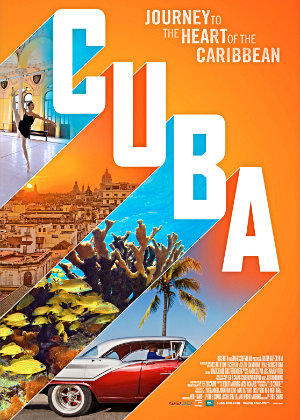 A new film will open in the reworked all digital Robert D. Lindner Family OMNIMAX Theater on June 7. A few previously shown films have appeared as part of the theater’s classic series but Cuba: Journey to the Heart of the Caribbean is only the second new production to be shown since the theater reopened in December following a long closure. A post on the reopening and the first film, Volcanoes, is here. There were two members-only showings of the new movie on Saturday and I jumped at the chance to attend. Volcanoes is an awesome movie; Cuba might be even better.
A new film will open in the reworked all digital Robert D. Lindner Family OMNIMAX Theater on June 7. A few previously shown films have appeared as part of the theater’s classic series but Cuba: Journey to the Heart of the Caribbean is only the second new production to be shown since the theater reopened in December following a long closure. A post on the reopening and the first film, Volcanoes, is here. There were two members-only showings of the new movie on Saturday and I jumped at the chance to attend. Volcanoes is an awesome movie; Cuba might be even better.
It’s the work of Golden Gate 3D, which I’ve now learned was responsible for two of my favorite 70-millimeter real film IMAX movies: Jerusalem and National Parks Adventure. The images are superb, from scenic panoramas to the microscopic; From world stopping slow motion to the super acceleration of time-lapse. The three storylines do a fine job of holding the film together and moving it along. Then there’s the music. ¡Ay caramba, the music! It grabbed me from the start and never let go through slow soaring overhead shots to frantic-paced dance scenes. I expected to see a long list of contributors when I scanned the credits but it appears that just two men composed all the original music: Andres Levin, who was also the film’s music supervisor, and José María Vitier. Wonderful stuff, fellows.
The storylines involve Havana’s official historian, an aspiring ballerina, and a pair of scientists. Eusebio Leal doesn’t just study history, he preserves it. He is responsible for saving and renovating many of the city’s numerous endangered buildings. He is also responsible for the only direct quote I recall from the movie: “Architecture is frozen music and we are a people who love music”.
It was a major surprise to me to learn that the world’s largest ballet school is in Havana. The movie follows Patricia Torres, one of the Cuban National Ballet School’s approximately 3,000 students, as she works to realize her dream of joining the Cuban National Ballet Company. Fernando Bretos and Daria Siciliano study Cuba’s coral reefs to discover why they are actually recovering while those in other parts of the world continue to decline. Their work provides the filmmakers an opportunity to show off their considerable underwater skills in recording some beautiful scenes.
Two of my favorite scenes are the result of underwater microscopic time-lapse recording. Siciliano tells us that the coral is not inanimate stone but is simply living at a different pace than us. The cameras then demonstrate. The scenes instantly reminded me of liquid light shows I saw in the 1960s. The great music certainly encouraged the idea that I was watching a brilliantly colored high-def high-tech version of hippy era stagecraft.
There was another flashback of sorts in plenty of shots of the legendary 1950s American automobiles that resourceful Cubans have kept in operation despite the long-standing complete embargo on parts. Of course, keeping the mostly brightly colored vehicles running is not the only place where the embargo and generally poor economy have led to uncommon ingenuity. Agriculture is one such area that is highlighted in the film.
The lack of money and materials is evident in the film from the aforementioned “classic” cars to the deterioration of buildings. Cuba: Journey to the Heart of the Caribbean doesn’t avoid or downplay this aspect of the politically isolated island but the bright and crisp images somehow make it less sad. The music might also have something to do with that. The faces certainly do.
The movie is filled with smiling faces, dancing feet, and drum pounding hands. Most of the people seen in the movie are happy. Of course, this is partly due to the fact that parades and other celebrations are frequent subjects. Not every face is smiling and not every scene is a happy one but there are a lot more grins than grimaces. Somewhere near its beginning, the film talks of Cuba existing in three different periods. There is its glorious past, its uncertain but promising future, and the present. The present is what it is. This movie might make things look a little better than they actually are but I don’t think that’s an intentional misrepresentation. I think its creators wanted to make a joyful and entertaining movie that included some seriously representative images. They used some of the best of the present and included a little bit of both the past and the future. When you see it, and I really recommend you do, be prepared to tap your toes and maybe dance in your seat a little. It’s gonna be hard not to.
